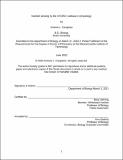| dc.contributor.advisor | Gehring, Mary | |
| dc.contributor.author | Cangelosi, Andrew L. | |
| dc.date.accessioned | 2022-08-29T16:07:34Z | |
| dc.date.available | 2022-08-29T16:07:34Z | |
| dc.date.issued | 2022-05 | |
| dc.date.submitted | 2022-05-23T19:54:16.503Z | |
| dc.identifier.uri | https://hdl.handle.net/1721.1/144727 | |
| dc.description.abstract | Cellular growth and metabolism must be linked to the environmental status of the cell to maintain organismal function. This coordination is achieved by mTORC1, a master growth regulator that senses and integrates a diverse array of environmental inputs, including nutrients like glucose and the amino acids leucine and arginine, whose sensing mechanisms are beginning to be identified. However, the role and implications of nutrient sensing by mTORC1 in mammalian physiology remains poorly understood.
Here, we identified a critical role of leucine sensing by mTORC1 in adapting to leucine availability in vivo. Mice lacking the leucine sensors Sestrin1 and Sestrin2 fail to inhibit mTORC1 in tissues when deprived of dietary leucine. These mice suffer from severe loss of white adipose tissue and skeletal muscle when deprived of leucine, but not other essential amino acids. We showed that their white adipose tissue loss results from mTORC1 dysregulation in the liver and is driven by aberrant production of the hepatokine FGF21. We also found that leucine sensing is compartmentalized within the liver, which is established by zonated expression of Sestrin1 and Sestrin2 in the liver lobule and demonstrates an unappreciated spatial organization of nutrient sensing in tissues.
Further, we identified a functionally-important temporal shift in nutrient sensitivity of the mTORC1 pathway in pancreatic β cells. We found that this shift is required for β cells to acquire glucose-responsive insulin secretion after birth. We further demonstrated that modulating nutrient-responsive mTORC1 activity can be therapeutically exploited to improve the generation of stem cell-derived β cells. Collectively, these findings demonstrate a subset of the likely many important roles of nutrient sensing by mTORC1 in physiology and begin to unravel the spatial and temporal complexity of nutrient sensing within tissues of the body. | |
| dc.publisher | Massachusetts Institute of Technology | |
| dc.rights | In Copyright - Educational Use Permitted | |
| dc.rights | Copyright retained by author(s) | |
| dc.rights.uri | https://rightsstatements.org/page/InC-EDU/1.0/ | |
| dc.title | Nutrient sensing by the mTORC1 pathway in physiology | |
| dc.type | Thesis | |
| dc.description.degree | Ph.D. | |
| dc.contributor.department | Massachusetts Institute of Technology. Department of Biology | |
| dc.identifier.orcid | https://orcid.org/ 0000-0002-6218-0399 | |
| mit.thesis.degree | Doctoral | |
| thesis.degree.name | Doctor of Philosophy | |
